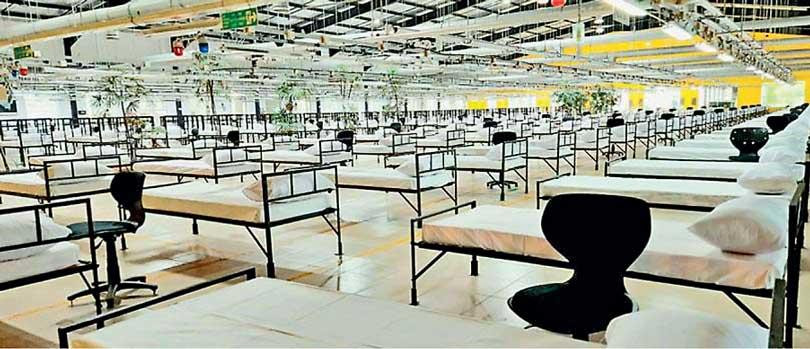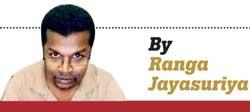11 May 2021 - {{hitsCtrl.values.hits}}

The largest COVID treatment hospital in the country was opened in Seeduwa. The hospital has a capacity to accommodate 1200 patients. (Army Media)
 On Sunday, Sri Lanka crossed the 2000 mark of daily COVID infections for the first time, recording 2672 cases. 15 deaths were reported. Though the authorities have attributed the sudden spike to the clearing of the backlog of PCR tests, which might not be the most reassuring assessment of the unfolding pandemic. Sri Lanka conducts around 25000 tests (On May 8, a total of 25177 were performed) and has a positivity rate of over 8%. Those numbers are simply under-reporting the full scale of the pandemic.
On Sunday, Sri Lanka crossed the 2000 mark of daily COVID infections for the first time, recording 2672 cases. 15 deaths were reported. Though the authorities have attributed the sudden spike to the clearing of the backlog of PCR tests, which might not be the most reassuring assessment of the unfolding pandemic. Sri Lanka conducts around 25000 tests (On May 8, a total of 25177 were performed) and has a positivity rate of over 8%. Those numbers are simply under-reporting the full scale of the pandemic.
International projections paint a much direr picture than what is officially reported. Institute of Health Metrics and Evaluation (IHME), a research institute of the University of Washington projects 20,876 total deaths in Sri Lanka by September 1, 2021. As many as 250 deaths were projected by the second week of June. Daily infections would peak at 55,620 on May 24 before gradually declining. The majority of them will go unreported.
Now several associations representing health practitioners, including Specialist doctors, GMOA, and Public Health Inspectors, have urged the government to tighten travel restrictions between the provinces. There are also calls for a lockdown, which is a politically inconvenient decision
As much as those projections are dire, they will be disputed by the local authorities. However, it serves the country to be prepared for the unknown, which would have far-reaching consequences to life and death and the economy.
The danger of not heeding to expert warning is now grimly in display in our neighbour across the Palk Straits. India has reported a record 400,000 plus daily infections and 4000 daily deaths. Many more go unreported and the county’s health system is overburdened.
Sri Lanka’s current spike in the pandemic is also a direct result of miscalculations that mimic India’s deadly blunders. In March, the Modi administration feigned a false premise that India was in the ‘endgame’ of the virus epidemic. Its self-righteous health authorities argued that the country has reached herd immunity, while the Indian Council of Medical Research, an independent think tank found only 21% of the population had anti-bodies.
Against the saner advice against the loosening of restrictions – and also in the wake of new variants and doubt mutations of the virus being discovered-, PM Modi allowed religious events such as Kumbh Mela, which became a super spreader.
Back here, Sri Lanka was on its way to crush the virus by March as the fresh cases were receding. However, the political will and commonsense were in short supply. Instead, the country let its guard down on the eve of the Sinhala Hindu New year. The rest is history. A well meaning government might have opted to a modest form of lockdown, like the European nations did before Christmas and most commonsensical Muslim countries have opted now in the aftermath of Ramadan.
Now several associations representing health practitioners, including Specialist doctors, GMOA, and Public Health Inspectors, have urged the government to tighten travel restrictions between the provinces. There are also calls for a lockdown, which is a politically inconvenient decision. Health authorities of the government keep dutifully parroting the political mantra of no lockdown. Before the New Year, they hesitated to forcefully advocate for at least a modest form of travel restrictions and a partial lockdown. All that time, they were also predicting an upswing of cases after the New Year. Politicization and militarization of the country’s anti-coronavirus strategy deprived it of the expertise of competent medical experts. The result is this. The current tragedy would however be dwarfed by in enormous proportions of a looming catastrophe if the political and military leaders keep thinking they know better than the qualified medical practitioners as to how to beat a medical contingency.
Lockdowns and restrictions are only temporary fixes that save lives, but also drain the economy and inconvenience the public. The only way out is the properly organized vaccination campaign. There again, Sri Lanka had vaccinated less than 5% of the population and with a shortage of vaccines in the international market, getting hold of the vaccine in adequate numbers would be a tall order and time consuming, though the Health Minister has said that the government would vaccinate 63% of the population by the end of this year.
Again, a pro-active local health administration would have aped the Western states and placed the orders before the supply chains got clogged. Administrative red tapes, even well-meaning ones effectively delayed Sri Lanka’s vaccination initiatives. The political leadership will now have to make use of their good offices to secure a ready supply of vaccines. That is a race against a swelling curve.
In the meantime, some of the government initiatives such as making 10,000 beds in 10 days though smack of a publicity stunt could well spare the country of the ugly sight of patients pilling up on corridors if the worst projections become true. According to the projections by the IHME, Sri Lanka will need 17,000 hospital beds plus 3400 ICU beds in the second week of June when the daily hospital admittance reaches its peak. Sri Lanka has less than 700 ICU beds. The Army has built a 1200-bed COVID treatment centre. While all that is appreciated, if it comes to the crunch, the entire health system would be overburdened, crippling the regular services.
As it prepares for a major upheaval of the virus, the government can still do much to blunt the force of the incoming wave. The only solution now is, at least a partial lockdown, while enabling that the basic economic and administrative functions of the state will continue.
Lockdown is a political and socially inconvenient choice. However, every day that passes without it is adding more to the toll. It increases the prospect of ‘LONG COVID’, a pandemic that lasts more than it was initially expected. If saving the economy is the rationale for not imposing a lockdown, a protracted pandemic would have a far more grievous blow to the economy. Again, India is a case in point. South Asia’s largest economy that was tipped to lead the regional recovery has ground to a halt. Few care about the economic growth numbers when the dead are piling up.
Follow @RangaJayasuriya on Twitter
29 Nov 2024 1 hours ago
29 Nov 2024 3 hours ago
29 Nov 2024 3 hours ago
29 Nov 2024 4 hours ago
29 Nov 2024 4 hours ago